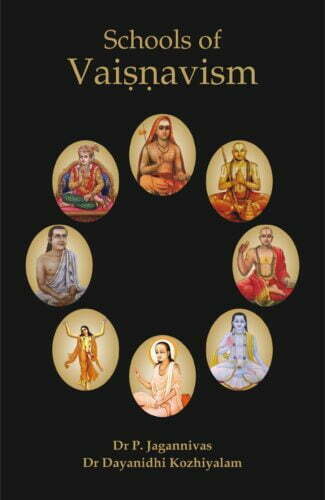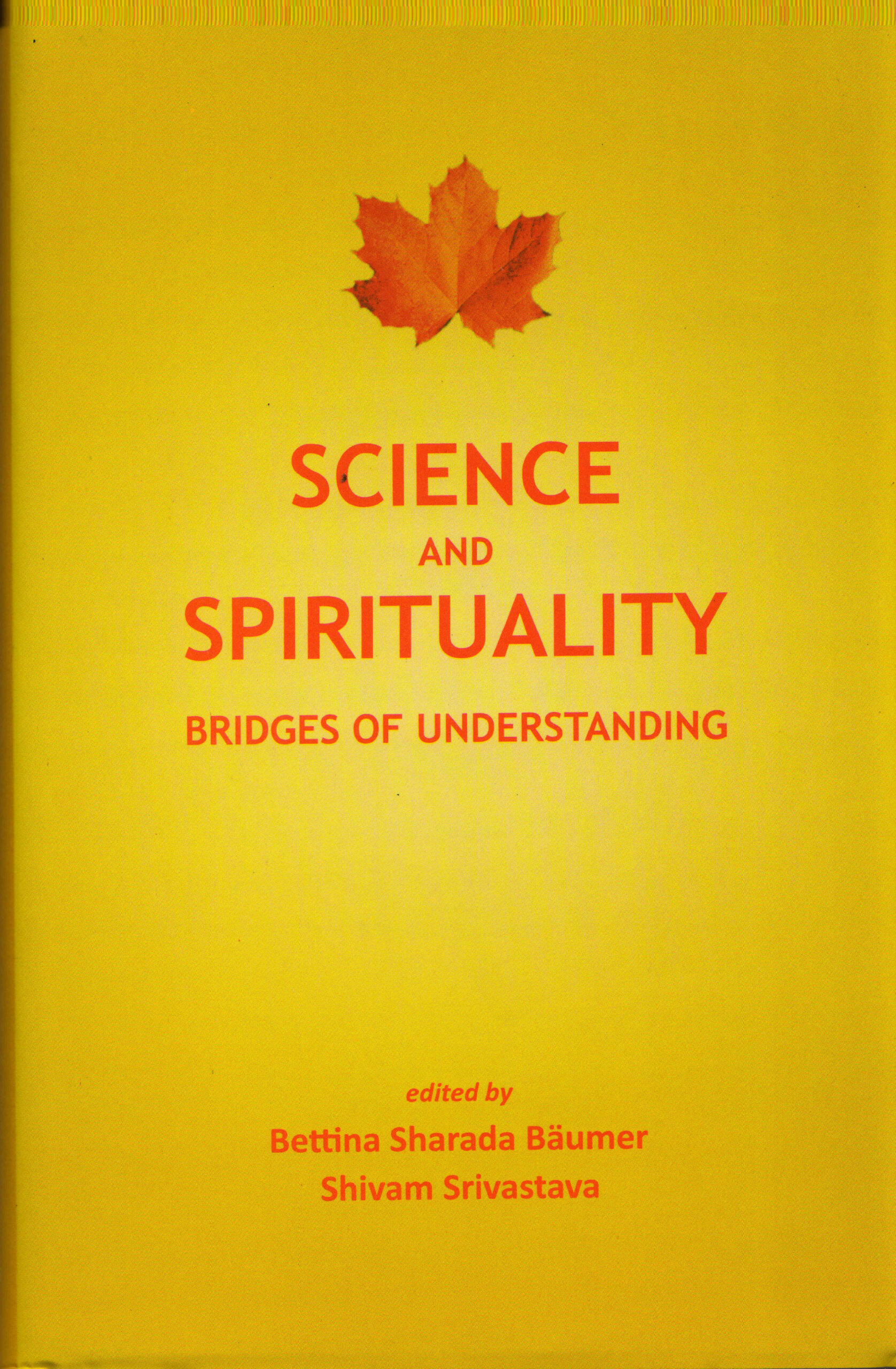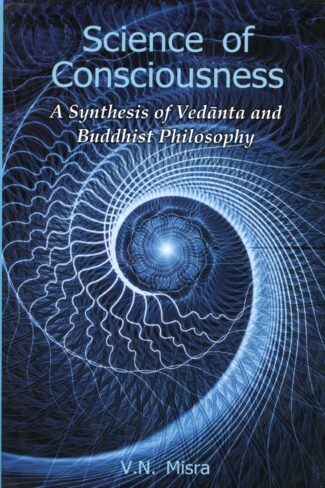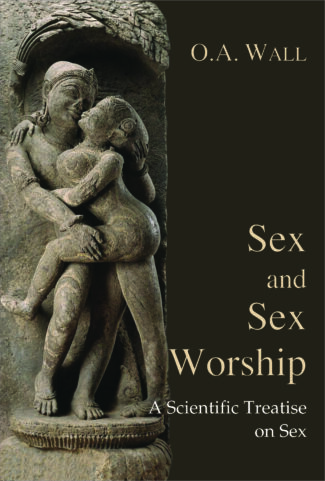Showing 41–50 of 66 results

The book provides a detailed study of the Vaisnava acaryas such as Sri Ramanuja, Sri Nimbarka, Sri Madhvacarya, Sri Caitanya, Sri Vallabha, Sri Sankaradeva and Sri Swami Narayana and their religious philosophies vis-à-vis Sri Sankara’s jnana theory.
The book provides a detailed study of the acaryas such as Sri Sankara, Sri Ramanuja, Sri Nimbarka, Sri Madhvacarya, Sri Caitanya, Sri Vallabha, Sri Sankaradeva and Sri Swami Narayana and their philosophies. The schools of Vaisnavism belonging to these venerable acaryas primarily promulgate for the seeker an alternate method which emphasizes that samsara is real, liberation is real, and worship and meditation are equally real, not mock battles. God is accepted as the Ultimate Reality – merciful and gracious, the seat of all auspicious attributes – by whose grace alone one can be freed from the bondage of samsara. These schools are well established in the Vedas and do not make a distinction between the Absolute (Brahman) and God (ISvara) or equate jiva with Brahman. Most of these schools, identify ISvara or Brahman with Visnu, who has a particular form (Catur-Bhujam, Sanku-Cakra, etc.) which distinguishes Him from other gods. All the acaryas of the schools of Vaisnavism had Lord Mahavisnu as the Supreme Reality, but for each one of them the Lord presented Himself in a different form. For example, for Sri Ramanuja, it was Sriman Narayana, for Sri Nimbarka, Sri Vallabha and Sri Caitanya it was Sri Krsna and for Sri Ramananda it was Sri Rama.
This volume should invoke keen interest in the philosophical community and among the followers of Vaisnava Sampradaya, along with a wide range of students, researchers and teachers of all religious philosophies.

The book provides a detailed study of the Vaisnava acaryas such as Sri Ramanuja, Sri Nimbarka, Sri Madhvacarya, Sri Caitanya, Sri Vallabha, Sri Sankaradeva and Sri Swami Narayana and their religious philosophies vis-à-vis Sri Sankara’s jnana theory.
The book provides a detailed study of the acaryas such as Sri Sankara, Sri Ramanuja, Sri Nimbarka, Sri Madhvacarya, Sri Caitanya, Sri Vallabha, Sri Sankaradeva and Sri Swami Narayana and their philosophies. The schools of Vaisnavism belonging to these venerable acaryas primarily promulgate for the seeker an alternate method which emphasizes that samsara is real, liberation is real, and worship and meditation are equally real, not mock battles. God is accepted as the Ultimate Reality – merciful and gracious, the seat of all auspicious attributes – by whose grace alone one can be freed from the bondage of samsara. These schools are well established in the Vedas and do not make a distinction between the Absolute (Brahman) and God (ISvara) or equate jiva with Brahman. Most of these schools, identify ISvara or Brahman with Visnu, who has a particular form (Catur-Bhujam, Sanku-Cakra, etc.) which distinguishes Him from other gods. All the acaryas of the schools of Vaisnavism had Lord Mahavisnu as the Supreme Reality, but for each one of them the Lord presented Himself in a different form. For example, for Sri Ramanuja, it was Sriman Narayana, for Sri Nimbarka, Sri Vallabha and Sri Caitanya it was Sri Krsna and for Sri Ramananda it was Sri Rama.
This volume should invoke keen interest in the philosophical community and among the followers of Vaisnava Sampradaya, along with a wide range of students, researchers and teachers of all religious philosophies.

A dialogue between science and spirituality is a necessity in our times where both, differences and mutual enrichment of the two great fields of human approach to reality, are taking place. This volume addresses this need from the perspective of different areas of science and spiritual traditions. The starting point is the intention of the founder of the IIAS, Dr S. Radhakrishnan, who saw that both the practice of science and experience of spirituality are intimately related to being human. Although much thought has gone into their relationship, the present volume intends to broaden and deepen the possibility of a harmonious integration, necessary to overcome the present-day crisis of humanity.
From the side of science, the contributors come from the fields of physics, plant biology, neuroscience, psychology, ecology and philosophy of science; and from the side of spirituality, following traditions and spiritual masters are represented: PÀtaðjala Yoga, Trika aivism of Kashmir, VedÀnta, Buddhism, Christianity, Theosophy, and Rabindranath Tagore, Swami Vivekananda and J. Krishnamurti. The deliberations included topics such as Awareness in plants, Neuroplasticity and Habit, appropriate use of terms such as Consciousness and Energy in different contexts, clarifying several issues concerning the on-going dialogue. The contributing scholars have built bridges of understanding, thus encouraging the reader to proceed further in this quest.
A dialogue between science and spirituality is a necessity in our times where both, differences and mutual enrichment of the two great fields of human approach to reality, are taking place. This volume addresses this need from the perspective of different areas of science and spiritual traditions. The starting point is the intention of the founder of the IIAS, Dr S. Radhakrishnan, who saw that “both the practice of science and experience of spirituality are intimately related to being human”. Although much thought has gone into their relationship, the present volume intends to broaden and deepen the possibility of a harmonious integration, necessary to overcome the present-day crisis of humanity.
From the side of science, the contributors come from the fields of physics, plant biology, neuroscience, psychology, ecology and philosophy of science; and from the side of spirituality, following traditions and spiritual masters are represented: PÀtaðjala Yoga, Trika Œaivism of Kashmir, VedÀnta, Buddhism, Christianity, Theosophy, and Rabindranath Tagore, Swami Vivekananda and J. Krishnamurti. The deliberations included topics such as Awareness in plants, Neuroplasticity and Habit, appropriate use of terms such as “Consciousness” and “Energy” in different contexts, clarifying several issues concerning the on-going dialogue. The contributing scholars have built “bridges of understanding”, thus encouraging the reader to proceed further in this quest.

The book concentrates on consciousness because of two reasons: (i) in consciousness, both being and becoming are involved and (ii) pure consciousness happens to be the essence of human nature. It further discusses concepts like One and Many, Time and Space of Buddhist philosophy and Vedānta have scientific support.
The synthesis between Vedanta and Buddhist philosophy has been attempted in this study on the ground that the former is the philosophy of “being”, whereas the latter happens to be the philosophy of becoming. The being and becoming, both are important for proper understanding of the Absolute Reality and its manifestation. In synthesizing, it has concentrated on consciousness because of two reasons: (i) in consciousness, both being and becoming are involved and (ii) pure consciousness happens to be the essence of human nature.
In Buddhist philosophy the concepts like citta-nirvana, bhavanga-citta and alaya-vijnana having a bearing on pure consciousness, which happens to be the Upanisadic atman and the Vedantic Brahman. Since these concepts represent the essence of human beings, the similarities among the Upanisads, Vedanta and Buddhism have been established. However, the differences between Vedanta and Buddhist philosophy (Yogacara Vijnanavada) on several issues like momentariness, changing reality will continue because these are merely modes of manifestations or appearances.
It has also been shown that the concepts like One and Many, Time and Space of Buddhist philosophy and Vedanta have scientific support. Time and Space have no independent existence in Buddhist philosophy and Vedānta. In fact, both being the manifestations of consciousness, become the objects of consciousness. It means that Buddhist philosophy and Vedanta have treated Time and Space in relative framework. So is the case with science.

Mankind, when it gave expression to its first dawning of religious thoughts, wove a fabric of myths and theories about religion, the warp of which ran through from earliest historical times to our own days as threads of the warp of philosophies and theories about sex, male, female, love, passion, lust, desire, procreation, offspring, etc. The succeeding ages and civilizations wove into its warp the woof of the individual religions, myths and fables of gods and goddesses, so that the whole fabric of beliefs became refined as mankind itself advanced.
Sex and Sex Worship is the result of a long-time, arduous study of the concept of sex and the worship of phallus in various civilizations and in the development of different religions, modern and old, over a period of many millennia. The book makes one grasp a lot of topics associated with sex and sex symbols such as nature of sex and reproduction, status of women, cosmo-gonies, sex in man and animal, sexual relationship of gods and goddesses, virgin worship, phallic festivals, among many, while making it clear that the worship of generative organs was rather a use of representations of phallus and yoni as symbols for certain religious ideas which were embodied in nature worship.
It also vividly talks about the concept of sex and sex organs in art and ethics, sculpture, art anatomy, etc. The contents in toto lead one to the myriad aspects and concerns associated with sex and phallic worship. It is a must read for a scholar and a common man alike.
Mankind, when it gave expression to its first dawning of religious thoughts, wove a fabric of myths and theories about religion, the warp of which ran through from earliest historical times to our own days as threads of the warp of philosophies and theories about sex, male, female, love, passion, lust, desire, procreation, offspring, etc. The succeeding ages and civilizations wove into its warp the woof of the individual religions, myths and fables of gods and goddesses, so that the whole fabric of beliefs became refined as mankind itself advanced.
Sex and Sex Worship is the result of a long-time, arduous study of the concept of sex and the worship of phallus in various civilizations and in the development of different religions, modern and old, over a period of many millennia. The book makes one grasp a lot of topics associated with sex and sex symbols such as nature of sex and reproduction, status of women, cosmo-gonies, sex in man and animal, sexual relationship of gods and goddesses, virgin worship, phallic festivals, among many, while making it clear that the worship of generative organs was rather a use of representations of phallus and yoni as symbols for certain religious ideas which were embodied in nature worship.
It also vividly talks about the concept of sex and sex organs in art and ethics, sculpture, art anatomy, etc. The contents in toto lead one to the myriad aspects and concerns associated with sex and phallic worship. It is a must read for a scholar and a common man alike.

Mankind, when it gave expression to its first dawning of religious thoughts, wove a fabric of myths and theories about religion, the warp of which ran through from earliest historical times to our own days as threads of the warp of philosophies and theories about sex, male, female, love, passion, lust, desire, procreation, offspring, etc. The succeeding ages and civilizations wove into its warp the woof of the individual religions, myths and fables of gods and goddesses, so that the whole fabric of beliefs became refined as mankind itself advanced.
Sex and Sex Worship is the result of a long-time, arduous study of the concept of sex and the worship of phallus in various civilizations and in the development of different religions, modern and old, over a period of many millennia. The book makes one grasp a lot of topics associated with sex and sex symbols such as nature of sex and reproduction, status of women, cosmo-gonies, sex in man and animal, sexual relationship of gods and goddesses, virgin worship, phallic festivals, among many, while making it clear that the worship of generative organs was rather a use of representations of phallus and yoni as symbols for certain religious ideas which were embodied in nature worship.
It also vividly talks about the concept of sex and sex organs in art and ethics, sculpture, art anatomy, etc. The contents in toto lead one to the myriad aspects and concerns associated with sex and phallic worship. It is a must read for a scholar and a common man alike.
Mankind, when it gave expression to its first dawning of religious thoughts, wove a fabric of myths and theories about religion, the warp of which ran through from earliest historical times to our own days as threads of the warp of philosophies and theories about sex, male, female, love, passion, lust, desire, procreation, offspring, etc. The succeeding ages and civilizations wove into its warp the woof of the individual religions, myths and fables of gods and goddesses, so that the whole fabric of beliefs became refined as mankind itself advanced.
Sex and Sex Worship is the result of a long-time, arduous study of the concept of sex and the worship of phallus in various civilizations and in the development of different religions, modern and old, over a period of many millennia. The book makes one grasp a lot of topics associated with sex and sex symbols such as nature of sex and reproduction, status of women, cosmo-gonies, sex in man and animal, sexual relationship of gods and goddesses, virgin worship, phallic festivals, among many, while making it clear that the worship of generative organs was rather a use of representations of phallus and yoni as symbols for certain religious ideas which were embodied in nature worship.
It also vividly talks about the concept of sex and sex organs in art and ethics, sculpture, art anatomy, etc. The contents in toto lead one to the myriad aspects and concerns associated with sex and phallic worship. It is a must read for a scholar and a common man alike.
“Dreams play a significant role in our life, meaningfully affecting us in the development of our personality and our spiritual journey. They are an everyday experience for any human being. Dreams have always been of great interest to poets and philosophers alike since ancient times and examples are aplenty in Indian and Western scriptures. However, it is an uphill task for an ordinary person to fully appreciate the intricacies and significance of dreams in the day-to-day life. It is here that this book proves as an invaluable guide providing deep understanding on the nature of dream and sleep.
This book is a repertoire of human wisdom – gathered for centuries and attested by the modern science – offering enormous insights into our dream and deep-sleep states. It asks, from a common man’s point of view, many a question that perturb us and provides answers to them from the scientific and spiritual perspectives in a captivating way. Some such questions include:
• Do we see dreams in black and white or in colour?
• What does a visually-challenged person see in his dreams?
• Why are some of our dreams extraordinarily vivid with electric colours, the clarity and brilliance of which, we may never encounter in our ordinary waking lives?
• Why are we non-reflective, irrational in our dreams?
• Are the dream time and waking time equal?
• How does our memory work in dream state? Why do we forget our dreams and is it possible to improve dream recall and cultivate awareness in dreams?
• Why do we fail to distinguish a dream object from the physical world object while we are dreaming?
• If the dream experience exactly feels like the real world and we fail to distinguish it from the waking world while we are dreaming, how can we be certain that we are not dreaming now?
• How does a dream contain various persons exhibiting opposite emotions at the same time when all the dream characters including the witnessing dreamer are produced out of single mind of the dreaming person?
• Can we intentionally transform the dream scenarios? If so, what would be the philosophical implications of it?
• Can dreams and sleeps be utilized for spiritual elevation?
… and many more questions we always wondered about the daily eight hours of our bed time, but never got the right answers to! We find new meanings and ways in dealing with our dreams in this volume, therefore, it is a must read for every dream enthusiast as well as any serious spiritual seeker.
“

The book critically analyses many philosophical concerns of both Sri Aurobindo and Teilhard de Chardin and talks about the future evolution. It involves recognizing parallel features as well as differences in both the philosophers.
Sri Aurobindo and Teilhard de Chardin: A Comparative Study ventures into identify the progressive rungs in the ladder of human consciousness pointed out by both the thinkers, to see how they visualize going beyond to achieve Sachchidanda, the Supreme Bliss. The scrutiny involves recognizing parallel features as well as differences in both the philosophers.
Their writings are extremely significant in a phase where the future of humanity is at risk. Sri Aurobindo, who is steeped in the Vedic wisdom of the ancient India, calls up on us to shed our selfish nature and reach the higher levels of consciousness. Teilhard de Chardin, a Jesuit priest, exhorts us to unite and shed divisions. There is a striking similarity in their cosmologies. Sri Aurobindos concept of Supermind is the last stage in evolution and Teilhards Omega Point is the summit of evolution. Their process of evolution contains a triple transformation of consciousness. The book critically thus analyses many philosophical concerns of both Sri Aurobindo and de Chardin and talks about the future evolution.
Indisputably one of the world’s best-known books, the Bhagavadgita embodies the quint-essence of classical Upanisadic philosophy, presented in the form of a dialogue between Krsna, the archetypal teacher, and Arjuna, the archetypal human being caught in the grip of a monumental crisis. For anyone like Arjuna who has ever paused to ponder the meaning of life, the work is as relevant today as it was when it was written.
By stripping away the manifold biases — both subtle and obvious — that have colored other commentaries, Guru Nitya has uncovered the perennial philosophy at the heart of this great classic. In an original, easy to understand format, his commentary divides each of the Gita’s eighteen chapters into three sections: the first elucidating the basic concepts involved; the second including Sanskrit text in Roman script along with the English meaning of each word or phrase and Nataraja Guru’s lucid and revolutionary English translation; and the third carrying explanatory notes and comments in the form of a dialogue between a teacher and student.
The breakthrough of this interpretation of the Gita is in its transcendence of sectarian dogma to reveal the work as a fully developed scientific psychology, whose keen insights and vivid reasoning can be readily appreciated by the twenty-first-century mind.

The Gospel of Buddha sketches the picture of a religious leader of the remote past with a view of make it bear upon the living present and become a factor in the formation of the future. It essentially talks about all major developments in the life of the Buddha and helps all true Buddhists understand the real tenets of Buddhism to stand firm on ground.
The Gospel of Buddha characterizes the spirit of Buddhism correctly and concisely. It draws parallelisms in Western thoughts, especially those which reflect in the Christian Gospels. Buddhism like Christianity has a number of sects and this book, however, does not side with any sectarian tenets, but takes an ideal position upon which all true Buddhists may stand up as on firm ground. It helps people to comprehend Buddhism better in an easy way and it sets the reader thinking on the problems and challenges of religions today.
It sketches the picture of a religious leader of the remote past with a view of make it bear upon the living present and become a factor in the formation of the future. It essentially talks about all major developments in the life of the Buddha – his transformation from Prince SiddhÀrtha to the Buddha, to his founding of the Kingdom of Righteousness, to the consolidation of his religion, to his teachings, and to the parables and stories that he used, to his last days.
This book is expected to serve both the Buddhists and Christians to penetrate deep into the spirit of their faith so as to see its full length, breadth and length.
| There are no products |